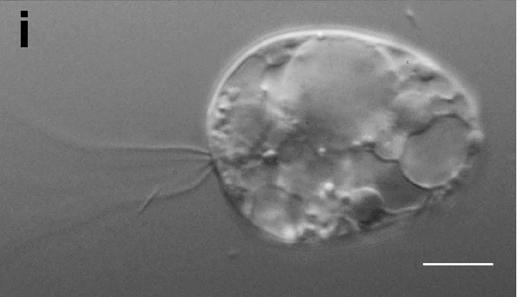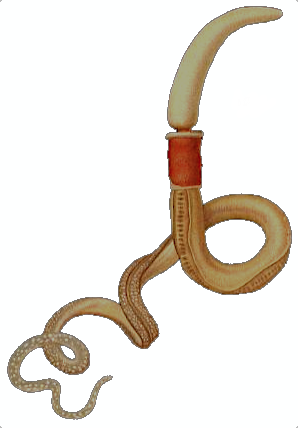|
Perkinsasida
Perkinsids are single-celled protists that live as intracellular parasites of a variety of other organisms. They are classified as the class Perkinsea within the monotypic phylum Perkinsozoa. It is part of the eukaryotic supergroup Alveolata, along with dinoflagellates, their closest relatives, and another parasitic group known as Apicomplexa. Perkinsids are found in aquatic environments, as parasites of dinoflagellates and various animals. Description All known Perkinsozoa are intracellular parasites of a range of organisms, particularly microalgae and animals. Species of Parviluciferaceae, Pararosariidae and '' Maranthos'' are parasites of dinoflagellates. ''Rastrimonas'' parasitize cryptophyte algae. Xcellidae, Perkinsidae and '' Acrocoelus'' are parasites of various animals: fish, bivalve molluscs and acorn worms, respectively. Perkinsozoa are found in aquatic environments, both marine and freshwater. Systematics Taxonomic history Perkinsids were first described ... [...More Info...] [...Related Items...] OR: [Wikipedia] [Google] [Baidu] |
Apicomplexa
The Apicomplexa (also called Apicomplexia; single: apicomplexan) are organisms of a large phylum of mainly parasitic alveolates. Most possess a unique form of organelle structure that comprises a type of non-photosynthetic plastid called an apicoplastwith an apical complex membrane. The organelle's apical shape is an adaptation that the apicomplexan applies in penetrating a host cell. The Apicomplexa are unicellular and spore-forming. Most are obligate endoparasites of animals, except '' Nephromyces'', a symbiont in marine animals, originally classified as a chytrid fungus, and the Chromerida, some of which are photosynthetic partners of corals. Motile structures such as flagella or pseudopods are present only in certain gamete stages. The Apicomplexa are a diverse group that includes organisms such as the coccidia, gregarines, piroplasms, haemogregarines, and plasmodia. Diseases caused by Apicomplexa include: * Babesiosis ('' Babesia'') * Malaria (''Plasmodium'') * Cr ... [...More Info...] [...Related Items...] OR: [Wikipedia] [Google] [Baidu] |
Supergroup (biology)
A supergroup or super-group, in systematics, is a large group of organisms that monophyletic, share one common ancestor and have important defining characteristics. It is an informal, mostly arbitrary rank in biology, biological Taxonomy (biology), taxonomy that is often greater than phylum or kingdom (biology), kingdom, although some supergroups are also treated as phylum, phyla. Eukaryotic supergroups Since the decade of the 2000s, the Eukaryote#Phylogeny, eukaryotic tree of life (abbreviated as eToL) has been divided into 5–8 major groupings called 'supergroups'. These groupings were established after the idea that only monophyletic groups should be accepted as ranks, as an alternative to the use of paraphyletic kingdom Protista. In the early days of the eToL six traditional supergroups were considered: Amoebozoa, Opisthokonta, "Excavata", Archaeplastida, "Chromalveolata" and Rhizaria. Since then, the eToL has been rearranged profoundly, and most of these groups were found as pa ... [...More Info...] [...Related Items...] OR: [Wikipedia] [Google] [Baidu] |
Cryptophagus (protozoa)
''Rastrimonas'' is a monotypic genus of parasitic alveolates in the phylum Apicomplexa. It contains the single species ''Rastrimonas subtilis''. It was described in 2002 from the free-living cryptomonad The cryptomonads (or cryptophytes) are a superclass of algae, most of which have plastids. They are traditionally considered a division of algae among phycologists, under the name of Cryptophyta. They are common in freshwater, and also occur ... '' Chilomonas paramaecium'' and placed in the new genus ''Cryptophagus''. The following year this was renamed ''Rastrimonas''. References {{Taxonbar, from=Q5191013 Apicomplexa genera Monotypic eukaryote genera ... [...More Info...] [...Related Items...] OR: [Wikipedia] [Google] [Baidu] |
Parvilucifera
''Parvilucifera'' is a genus of marine alveolates that behave as endoparasites of dinoflagellates. It was described in 1999 by biologists Fredrik Norén and Øjvind Moestrup, who identified the genus among collections of '' Dinophysis'' dinoflagellates off the coast of Sweden. Initially mistaken for products of sexual reproduction, the round bodies found within these collections were eventually recognized as sporangia, spherical structures that generate zoospores of a parasitic protist. This organism was later identified as '' P. infectans'', the type species. The examination of this organism and its close genetic relationship to ''Perkinsus'' led to the creation of the Perkinsozoa phylum within the Alveolata group. The complex life cycle of ''Parvilucifera'' consists of biflagellated zoospores that infect a variety of dinoflagellate species, become intracellular feeders or trophonts, and finally develop into sporangia that generate more zoospores. ''Parvilucifera'' specie ... [...More Info...] [...Related Items...] OR: [Wikipedia] [Google] [Baidu] |
Phylogenetic Analyses
In biology, phylogenetics () is the study of the evolutionary history of life using observable characteristics of organisms (or genes), which is known as Computational phylogenetics, phylogenetic inference. It infers the relationship among organisms based on empirical data and observed heritable traits of DNA sequences, protein amino acid sequences, and Morphology (biology), morphology. The results are a phylogenetic tree—a diagram depicting the hypothesis, hypothetical relationships among the organisms, reflecting their inferred evolutionary history. The tips of a phylogenetic tree represent the observed entities, which can be living Taxon, taxa or fossils. A phylogenetic diagram can be rooted or unrooted. A rooted tree diagram indicates the hypothetical common ancestor of the taxa represented on the tree. An unrooted tree diagram (a network) makes no assumption about directionality of character state transformation, and does not show the origin or "root" of the taxa in questi ... [...More Info...] [...Related Items...] OR: [Wikipedia] [Google] [Baidu] |
Perkinsus
''Perkinsus'' is a genus of alveolates in the phylum Perkinsozoa. The genus was erected in 1978 to better treat its type species, '' Perkinsus marinus'', known formerly as ''Dermocystidium marinum''. These are parasitic protozoans that infect molluscs, at least some of which cause disease and mass mortality. ''P. marinus'' is the most notorious, causing the disease perkinsosis, or dermo, in wild and farmed oysters.Petty, D''Perkinsus'' Infections of Bivalve Molluscs.FA178. Fisheries and Aquatic Sciences. Florida Cooperative Extension Service. University of Florida IFAS. 2010. Description ''Perkinsus'' is a genus in the class Perkinsea that is a parasite of bivalve molluscs; it displays a number of features typical of the dinoflagellates including laterally inserted heterodynamic flagella,. However, it has been settled that ''Perkinsus'' does not belong to the phylum Dinoflagellata, but rather into the phylum Perkinsozoa, which is the sister group In phylogenetics, a sist ... [...More Info...] [...Related Items...] OR: [Wikipedia] [Google] [Baidu] |
Genus
Genus (; : genera ) is a taxonomic rank above species and below family (taxonomy), family as used in the biological classification of extant taxon, living and fossil organisms as well as Virus classification#ICTV classification, viruses. In binomial nomenclature, the genus name forms the first part of the binomial species name for each species within the genus. :E.g. ''Panthera leo'' (lion) and ''Panthera onca'' (jaguar) are two species within the genus ''Panthera''. ''Panthera'' is a genus within the family Felidae. The composition of a genus is determined by taxonomy (biology), taxonomists. The standards for genus classification are not strictly codified, so different authorities often produce different classifications for genera. There are some general practices used, however, including the idea that a newly defined genus should fulfill these three criteria to be descriptively useful: # monophyly – all descendants of an ancestral taxon are grouped together (i.e. Phylogeneti ... [...More Info...] [...Related Items...] OR: [Wikipedia] [Google] [Baidu] |
Acorn Worms
The acorn worms or Enteropneusta are a hemichordate class of invertebrates consisting of one order of the same name. The closest non-hemichordate relatives of the Enteropneusta are the echinoderms. There are 111 known species of acorn worm in the world, the main species for research being '' Saccoglossus kowalevskii''. Two families— Harrimaniidae and Ptychoderidae—separated at least 370 million years ago. Until recently, it was thought that all species lived in the sediment on the seabed, subsisting as deposit feeders or suspension feeders. However, the early 21st century has seen the description of a new family, the Torquaratoridae, evidently limited to the deep sea, in which most of the species crawl on the surface of the ocean bottom and alternatively rise into the water column, evidently to drift to new foraging sites. It is assumed that the ancestors of acorn worms used to live in tubes like their relatives Pterobranchia, but that they eventually started to live a safe ... [...More Info...] [...Related Items...] OR: [Wikipedia] [Google] [Baidu] |
Bivalve
Bivalvia () or bivalves, in previous centuries referred to as the Lamellibranchiata and Pelecypoda, is a class (biology), class of aquatic animal, aquatic molluscs (marine and freshwater) that have laterally compressed soft bodies enclosed by a calcified exoskeleton consisting of a hinged pair of half-bivalve shell, shells known as valve (mollusc), valves. As a group, bivalves have no head and lack some typical molluscan organs such as the radula and the odontophore. Their gills have evolved into ctenidium (mollusc), ctenidia, specialised organs for feeding and breathing. Common bivalves include clams, oysters, Cockle (bivalve), cockles, mussels, scallops, and numerous other family (biology), families that live in saltwater, as well as a number of families that live in freshwater. Majority of the class are benthic filter feeders that bury themselves in sediment, where they are relatively safe from predation. Others lie on the sea floor or attach themselves to rocks or other h ... [...More Info...] [...Related Items...] OR: [Wikipedia] [Google] [Baidu] |
Fish
A fish (: fish or fishes) is an aquatic animal, aquatic, Anamniotes, anamniotic, gill-bearing vertebrate animal with swimming fish fin, fins and craniate, a hard skull, but lacking limb (anatomy), limbs with digit (anatomy), digits. Fish can be grouped into the more basal (phylogenetics), basal jawless fish and the more common jawed fish, the latter including all extant taxon, living cartilaginous fish, cartilaginous and bony fish, as well as the extinct placoderms and acanthodians. In a break to the long tradition of grouping all fish into a single Class (biology), class (Pisces), modern phylogenetics views fish as a paraphyletic group. Most fish are ectotherm, cold-blooded, their body temperature varying with the surrounding water, though some large nekton, active swimmers like white shark and tuna can hold a higher core temperature. Many fish can communication in aquatic animals#Acoustic, communicate acoustically with each other, such as during courtship displays. The stud ... [...More Info...] [...Related Items...] OR: [Wikipedia] [Google] [Baidu] |
Cryptophyte
The cryptomonads (or cryptophytes) are a superclass of algae, most of which have plastids. They are traditionally considered a division of algae among phycologists, under the name of Cryptophyta. They are common in freshwater, and also occur in marine and brackish habitats. Each cell is around 10–50 μm in size and flattened in shape, with an anterior groove or pocket. At the edge of the pocket there are typically two slightly unequal flagella. Some may exhibit mixotrophy. They are classified as superclass Cryptomonada, which is divided into two classes: heterotrophic Goniomonadea and phototrophic Cryptophyceae. The two groups are united under three shared morphological characteristics: presence of a periplast, ejectisomes with secondary scroll, and mitochondrial cristae with flat tubules. Genetic studies as early as 1994 also supported the hypothesis that ''Goniomonas'' was sister to Cryptophyceae. A study in 2018 found strong evidence that the common ancestor of Cryptomo ... [...More Info...] [...Related Items...] OR: [Wikipedia] [Google] [Baidu] |




